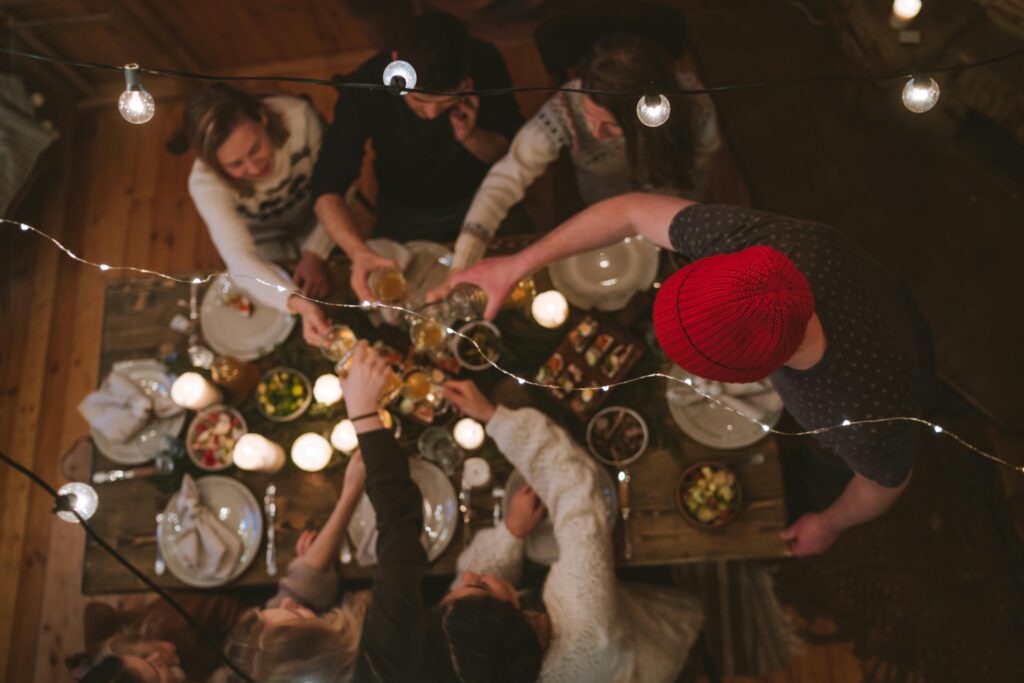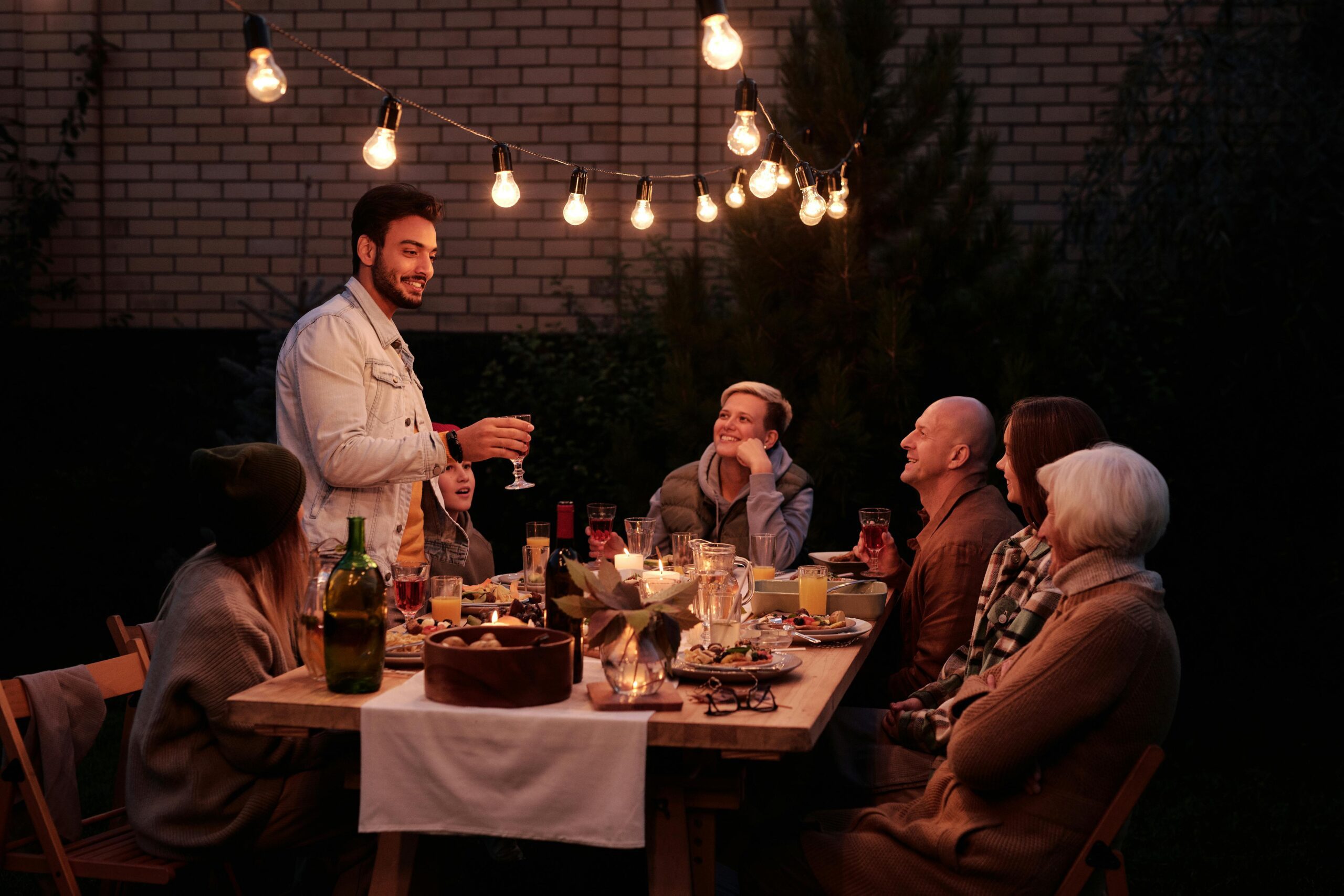Reimagining the Dinner Party: From Martha Stewart to the New Era of Entertaining
2025 is the year of the dinner party. A long held tradition, gathering around a meal with friends, will be a highlight of this year’s social scene. From the resurgence of Martha Stewart’s career, dinner parties are once again cast into the lime light. From the carefully planned shindigs of the 80’s to the laid-back imaginative styles of Gen Z there is a party perfect for any style. Food, entertainment, and culture converge as the conversation shifts to dinner.

The Martha Stewart Legacy
Martha Stewart has been the face of dinner party culture since the early 80s. Her 1982 book Entertaining marked the beginning of a media empire and changed the way Americans thought about hospitality. Her detailed guides, which included everything from lavish menus to décor tips, made high-society hosting accessible to the everyday person. According to Jaya Saxena, Stewart’s rise to prominence in the 1990s helped establish her as a near-ubiquitous media presence, thanks to her magazine, TV shows, and even partnerships with retail giant Kmart (Saxena, 2024). Stewart’s influence extended beyond catering and decorating to creating an aspirational lifestyle, blending wealth, perfection, and beauty with practical tips that purportedly made it possible for anyone to entertain like a professional.
Yet, beneath the polished surface of her brand, Stewart’s world has always been tinged with complexity. While Entertaining promised elegance and ease, Saxena notes that following Stewart’s instructions often led to stress and a sense of unattainability. The elaborate cocktail parties described in her book, such as the famous 1982 cocktail party menu featuring quiches and carpaccio, required significant time, energy, and money—resources that many simply did not have (Saxena, 2024). Despite her promises of simplicity, Stewart’s approach to entertaining remained a luxury that reflected the yuppie aspirations of the Reagan era.
The Decline of Elitism and the Rise of Connection
In recent years, hosting has become more about fostering community and connection than adhering to an unattainable ideal. The notion of the dinner party has shifted, especially for younger generations like Gen Z. No longer centered on formality, today’s dinner parties are more about creativity, intimacy, and shared experiences. As Gen Z creatives increasingly turn to hosting, they are reimagining the dinner party as a social event that emphasizes artful meals and community-building rather than perfection (Cannon, 2024).
This shift is partly in response to the pervasive loneliness faced by many Gen Z individuals. While highly connected online, young people today often experience social isolation, particularly in urban environments where opportunities for casual bonding are limited (Stone, 2024). As a result, dinner parties have become a tool for building meaningful in-person connections. Alessandra Brontsema, a dinner party enthusiast and creator, notes that hosting a themed gathering provides an opportunity for relaxation, bonding, and expression in a more informal setting (Brontsema, 2024). Additionally, Pinterest’s 2024 Summer Trends Report highlights that themed dinner parties—ranging from floral tea parties to Greek-inspired feasts—have seen a 6,000% increase in search interest, underscoring the widespread appeal of this modern hosting trend (Pinterest, 2024).
Social Media’s Impact on the Modern Dinner Party
Social media platforms, particularly TikTok and Instagram, have further democratized the dinner party, allowing creators to showcase their events to a global audience. Influencers like Amelia Edmondson, who shares her dinner party experiences on TikTok, have gained significant followings by highlighting how small details—such as simple flowers or personalized touches—can elevate an event without requiring a lavish budget (Edmondson, 2024). For many young people, these online platforms provide inspiration, making dinner parties feel accessible and relatable, even if they don’t involve the designer kitchens or expensive ingredients that Stewart’s era celebrated.
Yet, as Stewart’s world of “beautifully imperfect” gatherings gave way to social media-driven aesthetics, the traditional elements of the dinner party—meaningful conversation, good food, and genuine connections—have sometimes taken a backseat. Gabrielle Hamilton, reflecting on the evolution of the dinner party in her essay The Grown-Ups’ Table, laments the rise of smartphones at the dinner table, which have shifted the focus away from organic conversation toward digital distractions (Hamilton, 2024). Hamilton suggests that technology has created change, but it doesn’t have to diminish the experience. Embrace the idea that the occasional interruptions — such as a drunken toast or an unexpected guest — can spark spontaneity and authenticity.
Dinner Parties as a Pathway to Connection
Despite these challenges, there is hope for the future of dinner parties. For Gen Z, hosting remains an accessible and powerful way to connect. As The Loneliest Generation explores, meal-centric gatherings offer a structured, yet relaxed, way to meet new people and strengthen bonds (Stone, 2024). Unlike the high-pressure events that Stewart popularized, modern dinner parties emphasize the importance of building connections rather than meeting impossible standards. Edmondson cleverly reminds us a successful dinner party doesn’t need to be “Instagrammable” — authentic connection forged between the guests is the real focus. (Edmondson, 2024).
While the world’s social isolation increases, the need for dinner parties grows. Remember it isn’t about the size or the expense of the gathering; it’s creating a community that offers self-expression, friendship, and emotional growth.
Conclusion
Luckily the era of aspirational perfectionism entertaining is slowly being replaced by a more relaxed inclusive culture focused on community connection. The elegance and grace of the 1980’s has been embedded into a more relaxed “everyday living” atmosphere. The parties of today are less focused on the visual display and instead are centered on personal connection. This shift in culture, points to our society’s desire for human connection in a technological world. As the tech world progresses, the need for the kitchen table holds strong.

References:
- Cannon, S. L. (2024, September 7). Dinner Party Culture Is Back On The Menu For Gen Z Creatives. Forbes. https://www.forbes.com
- Edmondson, A. (2024). Interview on the Rise of Dinner Parties. Forbes.
- Hamilton, G. (2024). The Grown-Ups’ Table. Bon Appétit. https://www.bonappetit.com
- Pinterest. (2024). Pinterest 2024 Summer Trends Report. Pinterest.
- Saxena, Jaya. (2024, November 8). What replicating a cocktail party from Martha Stewart’s first book taught me about Martha, and the good life. Eater. Eater.com
- Stone, S. (2024, June 10). The “Loneliest Generation” Is Transforming the Dinner Party. Bon Appétit. https://www.bonappetit.com
Jenica “Hen” Weyand is a seasoned writer and creative professional with over 20 years of experience in brand storytelling, art, fashion, trends, and lifestyle. With a background in theater, design, and brand experience, Jenica continues to shape conversations around art, style, and modern living.
Jenica Weyand





